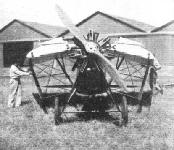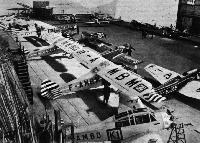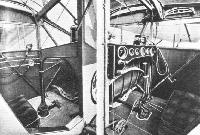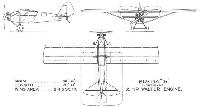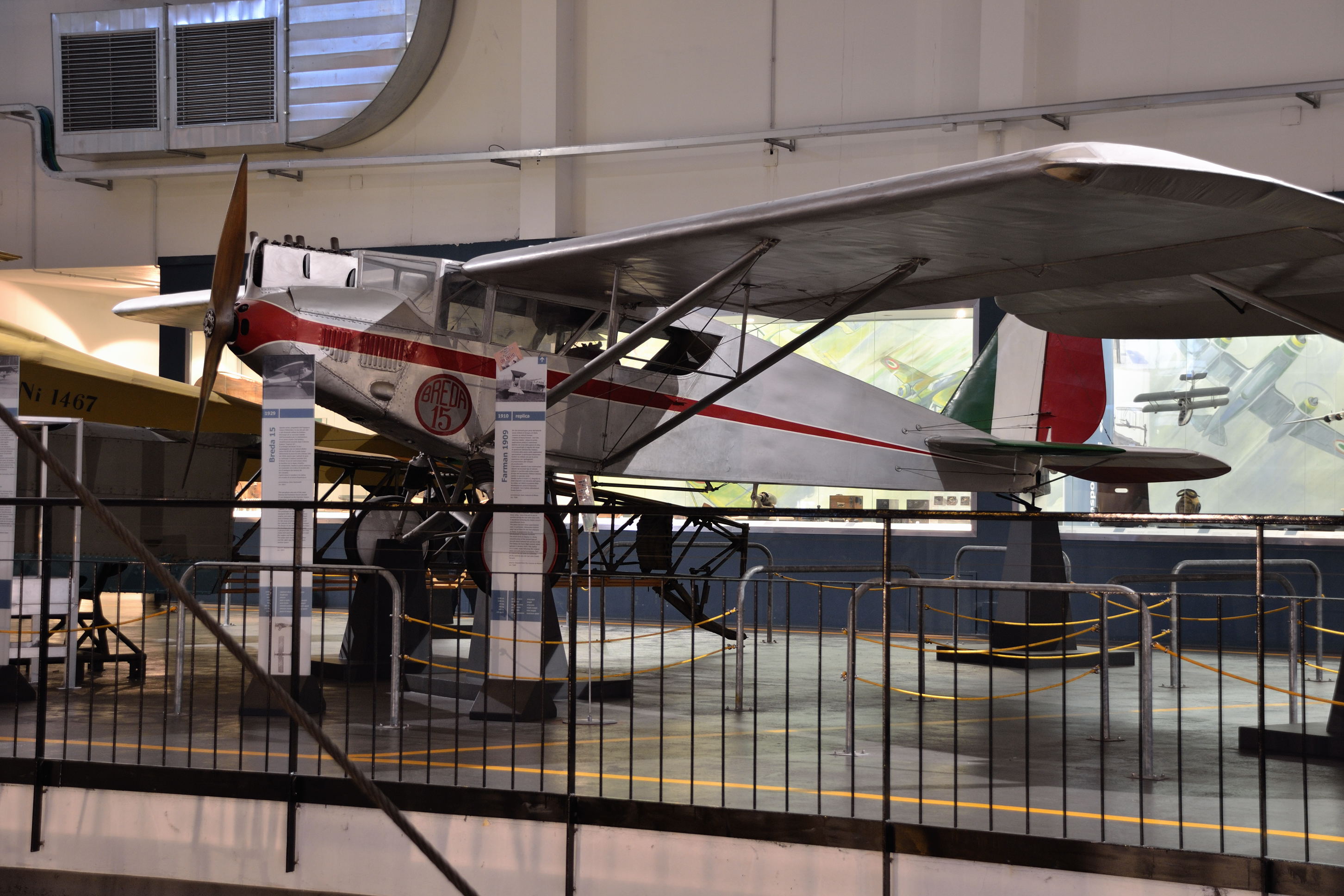
Flight, May 1929
THE BREDA "15"
An Italian Light Monoplane with 85 H.P. Walter Engine
IN a previous issue of FLIGHT (March 15, 1928), we described the Breda A.7 monoplane, constructed by a well-known and old-established Italian engineering and aircraft firm - Societa Italiana Ernesto Breda, of Milan - which was a successful high-wing reconnaissance machine with a 500-h.p. engine. Since then this firm has continued its development of other types of aircraft, and we are able this week to give a description of one of its latest products.
Just recently the Italian Air Ministry put forward a programme for the encouragement of Civil Aviation, with the result that the "light 'plane" - or medium-powered touring aeroplane, as it is classed in Italy - received a large share of attention from aircraft designers. Several of these have been produced by various firms in Italy, among them the Breda Co., mentioned above, and it is to this machine our description refers.
The Breda "15" - the machine in question - also is a high wing monoplane, equipped with an 85 h.p. Walter air-cooled radial engine, although we understand that other power plants of similar horse-power can, if desired, be installed. With a view to providing the utmost possible comfort for the pilot and passenger - it is a two-seater machine - considerable attention has been devoted to the accommodation and the controls. As regards the former, the two seats, which are arranged in tandem, are enclosed in a roomy cabin, formed by extending the top of the fuselage from the tail up to the level of the wings, the roof, front and sides, in the vicinity of the seats being composed of windows of non-flam material, thus providing an excellent range of vision. The windows can easily be opened at will, so as to ensure proper ventilation.
The seats are well upholstered, and are so designed that parachutes can be carried without discomfort. Access to the cabin, which is 2 ft 3 in. wide, and 4 ft. high, is by way of two doors of ample proportions in the side of the fuselage. The Breda patent dual control is fitted, in which the pilot, who normally occupies the rear seat, can disconnect the front controls during flight.
The cabin is well equipped with instruments, which include air speed indicator, revolution counter, compasses, altimeter, petrol and oil gauges, fire extinguishers, etc. Complete equipment for night flying is also fitted, including the regular four navigation lights, landing head light and cabin lighting, all supplied by a dynamo with "buffer" battery. Provision is, of course, made for carrying a normal amount of luggage.
As regards the construction - which is a combination of wood and steel tubing - of the Breda "15," this, we believe embodies several features of previous Breda practice, and special attention has been paid with regard to incorporating many interchangeable parts, thus ensuring the supply from stock of any spare part.
Although this machine has a comparatively low empty weight (926 lbs.) it is particularly robust, in fact we understand that every part in the construction has been tested under the same conditions and requirements which apply in the construction of the service machines produced by this firm. The wing has a factor of safety of 7.
The wings which are of fairly thick section, are of special design, giving a very good high/low speed ratio, and this is further improved by an arrangement whereby the incidence of the ailerons may be varied independent of and without interfering with their normal duties of lateral control. Ease and sensitiveness of control are characteristic features of the Breda "15" and a device has been provided which makes it possible for the pilot to set his controls in a given position and fly for long periods without further attention.
Another important feature is that the wings are made to fold back along the fuselage - an operation easily accomplished without any special tools in a few seconds. It can also easily be converted from a land plane to a seaplane.
The Breda "15," in spite of its comparatively low power, has a very good performance, and excellent climbing qualities, it can carry out all aerobatic manoeuvres with full load. During the recent Italian Government Competition for light 'planes this machine put up an exceptionally fine performance.
The principal characteristics, with 85 h.p. Walter engine are:
Span 36 ft. 6 in. (11-18m.).
Overall length 22 ft. (6-75 m.).
,, height 8 ft. 3 in. (2-525 m.).
Width folded 11 ft. 6 in. (3-50 m.).
Wing area 214-3 sq. ft. (20 sq. m.).
Weight empty 926 lbs. (420 kg.).
Useful load 617-5 lbs. (280 kg.).
Total weight 1,543-5 lbs. (700 kg.).
Power loading 18-1 lbs./h.p. (8-22kg./h.p.).
Wing loading 7-2 lbs./sq.ft. (35kg./sq.m).
Speed range 37-112 m.p.h. (60-180 k.p.h.).
Cruising speed 87 m.p.h. (140 k.p.h.).
Climb to 2,280 ft. (1,000 m.) 8 seconds.
Service ceiling 14,100 ft. (4,300 m.).
Endurance with full load 6 hours.
,, with pilot only 12 hours.
Описание:
- Flight, May 1929
THE BREDA "15" - Flight, June 1929
OLYMPIA AERO SHOW 1929 - Flight, April 1930
AIRCRAFT FOR THE PRIVATE OWNER - Flight, October 1933
THE UGO ANTONI WING
Фотографии
-
Flight 1929-05 / Flight
Регистрационный номер: I-AADE THE BREDA 15: View of the new Italian light 'plane.
-
Flight 1929-07 / Flight
AN ITALIAN CONTRIBUTION: The Breda 15 is a cabin two-seater light 'plane with Colombo S.53 engine.
-
Flight 1929-08 / Flight
Регистрационный номер: I-AAAO THE FOLDING TEST AT ORLY: (4) One of the Breda 15 monoplanes with Cirrus engine.
-
Flight 1930-04 / Flight
Регистрационный номер: G-AAVL [5] -
Flight 1930-10 / Flight
Регистрационный номер: G-AAVL [5] A further selection of small cabin aircraft: the Breda (Gipsy I);
-
Flight 1930-03 / Flight
Регистрационный номер: G-AAVL [5] THE BREDA-GIPSY LANDPLANE: A very low stalling speed of below 30 m.p.h. is claimed for this version of the Breda, together with a top speed of 105 m.p.h. when fitted with the Gipsy engine.
-
Flight 1930-04 / Flight
Регистрационный номер: G-AAVL [5] -
Flight 1931-06 / Flight
Регистрационный номер: OO-ALI BREDA DEVELOPMENTS: Our illustration shows view of the new Breda "15" light monoplane, fitted with a 110 h.p. "Argus A.S.8" inverted engine.
-
Flight 1932-09 / Flight
A FAIR ITALIAN VISITOR: Miss Gaby Angelini, an Italian pilot, who is making a solo flight to the principal towns of Europe in her Breda 15, at Heston, where she arrived last week. She has already visited Prague, Berlin, Stockholm, Copenhagen and Amsterdam, and next she will fly to Paris, Lyons, Cannes, Geneva and home to Milan.
-
Flight 1930-07 / Flight
MONOPLANE WITH WALTER ENGINE: The Breda 15 entered by Broccard and Pierroz, and piloted by Pierroz. This machine is a Swiss entry.
-
Flight 1930-10 / Flight
AN ECHO OF THE "CIRCUIT OF ITALY": Our picture shows Col. Sacchi in the Breda 15-S (120-h.p. Walter) landing at Rome during the Circuit of Italy competition, held last August. Col. Sacchi, it will be remembered, was declared the winner of this contest.
-
Flight 1929-05 / Flight
THE BREDA 15: View of the new Italian light 'plane as a seaplane.
-
Flight 1929-11 / Flight
Регистрационный номер: I-AANX [2] An Anglo-Italian Alliance: A Breda 15 light seaplane equipped with a "Cirrus" engine. This particular seaplane has taken up over 2,000 passengers at Viareggio within a period of three months without any trouble from either machine or engine.
-
Flight 1930-03 / Flight
Регистрационный номер: I-AANX [2] THE BREDA-CIRRUS SEAPLANE: The Breda 15 is another of many machines fitted with the Cirrus engine. It is very fully equipped and agencies are now being appointed in this country.
-
Flight 1931-07 / Flight
A NEW BREDA DEVELOPMENT: In our issue for June 12 last we published illustrations of a Breda "15" light plane fitted with an inverted engine, which provided greatly improved vision. Above we show another development, a Breda "15" seaplane fitted with an 105 h.p. Isotta-Fraschini Asso 80 Ri. 6-cyI. engine. This is an upright in line engine, but fitted with reduction gear which enables the engine to be placed low down in the fuselage, thus retaining the features of the upright type with the advantages of the inverted engine. The main characteristics of this machine - which has wooden wings and welded steel tube fuselage - are: span, 38 ft. 9 in.; wing area, 236-7 sq. ft.; weight empty, 1,279 lbs.; useful load, 617-4 lbs.; total weight, 1,896-4 lbs.; speed range, 43 - 105 m.p.h.; climb, 8,200 ft. in 21 min.; duration (cruising speed), 5 hrs. The Breda Company are delivering 100 of these seaplanes to civilian aero clubs in different parts of Italy.
-
Flight 1930-05 / Flight
AT MILAN AERO SHOW: The Breda stand. Here was the very neat "Breda 15" light seaplane.
-
Flight 1930-07 / Flight
Регистрационный номер: G-AAVL [5] FOREIGN COMPETITORS: The Breda and Klemm at the flying meeting.
Другие самолёты на фотографии: Klemm L.25 - L.28 Swallow - Германия - 1927
-
Flight 1932-08 / Flight
Регистрационный номер: OK-WAL SOME OF THE FOREIGN COMPETITORS: In the foreground the French machines, Guerchais, Potez, Farman and Caudron.
T1 OK-WAL - Breda Ba-15S, pilot Jan Anderle (Czechoslovak team)Другие самолёты на фотографии: Breda Ba.33 / Ba.39 / Ba.42 - Италия - 1931Caudron C.230 / C.270 / Luciole - Франция - 1930Farman F.230 / F.350 - Франция - 1930Guerchais T.9 - Франция - 1930Mauboussin Corsaire / M-120 - Франция - 1932Potez Potez 43 / 58 - Франция - 1932Praga BH-111 - Чехословакия - 1932PZL PZL.19 - Польша - 1932RWD RWD-6 / RWD-9 / RWD-20 - Польша - 1932
-
Flight 1930-04 / Flight
Регистрационный номер: G-AAVN The "Breda," from Italy, makes a first appearance at a British flying meeting, piloted by Mr. Store.
-
Flight 1929-08 / Flight
AT ORLY: Two of the Breda 15 monoplanes starting on their second lap in the consumption test.
-
Flight 1929-08 / Flight
PETROL TEST AT THE ORLY MEETING: (1) Cant.26, an Italian machine with Isotta Fraschini 80 h.p. engine, and a Breda monoplane (Cirrus)
Другие самолёты на фотографии: CANT CANT 26 - Италия - 1928
-
Flight 1933-09 / Flight
Регистрационный номер: G-ABCC [5] THE ANTONI VARIABLE CAMBER WING: As reported in our last issue a successful test was made at Brockworth on September 8 with a Breda fitted with this wing. Our picture shows the machine in flight.
-
Flight 1933-10 / Flight
Регистрационный номер: G-ABCC [5] ON TEST AT BROCKWORTH AERODROME: The Breda monoplane on which the Antoni variable camber wing has been mounted.
-
Flight 1933-10 / Flight
Регистрационный номер: G-ABCC [5] IN THE TWO EXTREME POSITIONS: On the left, the wing is shown flat, while on the right it is shown in maximum camber position.
-
Flight 1933-10 / Flight
Регистрационный номер: G-ABCC [5] THE STABILISERS: Near the wing roots the trailing edge is reflexed and flexible, and serves to give longitudinal stability.
-
Flight 1933-10 / Flight
Регистрационный номер: G-ABCC [5] Mr. Ugo Antoni, the designer of the variable camber wing.
-
Flight 1929-08 / Flight
MEASURING PETROL AT ORLY: One of the Breda 15 monoplanes after the test.
-
Flight 1929-05 / Flight
The Breda 15: Two views of the interior of the cabin, showing on the right the pilot's or rear seat, and on the left the passenger's, which is in front.
-
Flight 1931-06 / Flight
BREDA DEVELOPMENTS: Our illustration shows view of the new Breda "15" light monoplane, fitted with a 110 h.p. "Argus A.S.8" inverted engine. The installation of an inverted engine in this machine has been the means of considerably improving the view forward from the cabin - as may be gathered from the illustration, showing an interior view from the rear seat. We understand that the inverted D.H. "Gipsy" and "Cirrus Hermes" engines will also be fitted in the "15-S" machines.
-
Flight 1929-08 / Flight
View of Dashboard on "Breda"
-
Flight 1929-07 / Flight
ON THE BREDA 15: On the right the split undercarriage, and on the left the tail skid.
-
Flight 1933-10 / Flight
THE ANTONI VARIABLE CAMBER SYSTEM: The upper and lower diagrams indicate the action of the wing, while the numbered sketches show the structural details at various points.
-
Flight 1929-05 / Flight
Breda "15" Lightplane 85 hp. Walter Engine
- Фотографии














